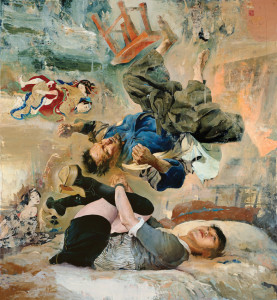Los Angeles artist Kent Williams makes imaginative, unique figurative pictures full of intrigue, ambiguity and haunting allure in his solo exhibition “Native Bone and Far to Home.”
His subjects, only partially visible in “Tomorrow,” for instance, coexist in an edgy and energetic visual tableau. They float comfortably in and out of spaces he paints using gestural brushwork and passages of decorative pattern. Both facets create a flattening visual effect. The realistic figurative elements, combined with seemingly unrelated areas of the composition, make for an irresistible Rubik’s Cube-like puzzle to decode.
The artist often foreshortens his subjects, to heighten the viewer’s relationship to them.
In “Studio Arrangement in Blue and Rose,” a female and male figure kneel on a workshop floor surrounded by paint cans, small propane torches, a fan and a bright orange electrical cord. Look closely and the artist appears to use a single side-by-side composition: The torches and paint cans are similar in placement to his subjects. Held in both hands by the male figure, the cord snakes left to right into and through the composition, between the figures, then upwards to a suspended shop lamp.
In the foreground, the young woman’s lower body is turning away and into the recesses of the picture. Simultaneously, her upper torso rotates outward toward the viewer and she gazes downward perhaps in a moment of introspection. We might wonder why the two subjects are painted together in spite of their apparent disinterest in one another.
It’s a beautifully sensuous picture, with a heightened air of aloofness and vulnerability. Though not explicit, the artist’s painting epitomizes loneliness and isolation.
Williams, a native North Carolinian (he was born in New Bern in 1962), uses historical references in “Ukiyo” to riff on Japanese-Edo period Ukiyo-e woodblock prints and paintings.
The originals are widely known as “pictures of the floating world.” Their often hedonistic subject matter included folk tales, kabuki actors and erotica. In Williams’ “Ukiyo,” a male clothed in karate-styled clothing hovers upside down mid-composition beneath a falling chair. Williams paints images of geisha around the painting’s principal subjects, reminding us of the haunting vestiges of female objectification. A young, contemporary-clothed Japanese woman lies comfortably on a bed, gazing off into space as if to reflect on a different future for herself and Japanese women.
The dynamic, topsy-turvy composition embodies the spirit of the period but with a difference: It isn’t the female who is objectified or on uncertain ground here, but rather the male who hovers, disoriented and ungrounded, in the space above her.
These bold and inventive pictures provoke not because they offer specific stories that we can immediately understand. Instead, the artist combines exquisite painted surfaces – expressionistic, realistic and decorative – and unclear hustle-and-bustle scenery to provoke us to see his inspired ambiguity.
Image: Ukiyo, 2010, oil on linen, 54 x 50 in., Tia Collection
Read the original article from the Charlotte Observer here.

